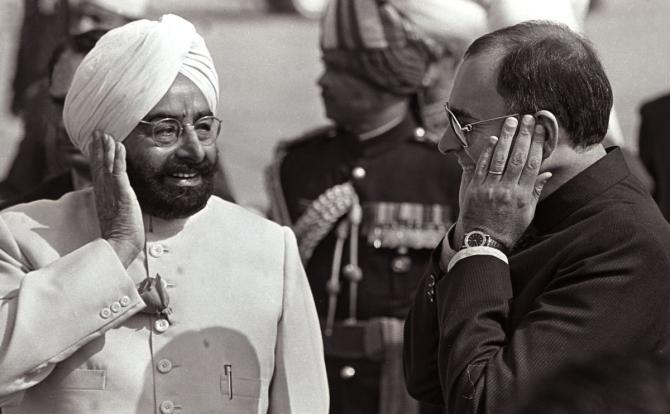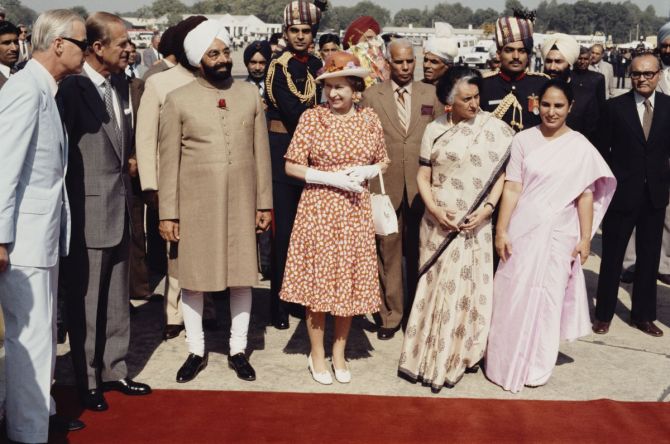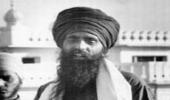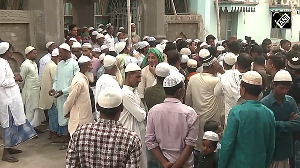How could a President, seen as a political time-server, have manoeuvred things to a stage where he could strike fear into the heart of a prime minister who, only two-and-a-half years before, had been elected with the largest majority in history?

It is common now for political commentators to remark on the similarities between Indira Gandhi's style of functioning and the current regime.
But what often passes without comment is that both Mrs Gandhi and Narendra Modi also have the same approach to appointing Presidents.
As K C Singh points out in this informative and extremely readable book, The Indian President: An Insider's Account of the Zail Singh Years (1982-87), Presidents were never intended to be rubber stamps or mere ceremonial figures.
They were expected to be figures of substance who contributed to national discourse.
And yet they didn't count for much politically under Mrs Gandhi or now, in this era.
You could argue that Indira Gandhi's decision to elevate Giani Zail Singh to the office had something to do with his minority status as a Sikh. But there was more to it than that.
Zail Singh was a shrewd politician who had been chief minister of Punjab and home minister of India.
He was unfailingly loyal to Mrs Gandhi and drew some of his political power from his proximity to Indira's private secretary R K Dhawan.
It is a measure of how much Mrs Gandhi subverted our institutions that Dhawan was the second most powerful person in India, to whom even senior cabinet ministers deferred.
It seems likely that the decision to make Zail Singh President emerged out of a combination of factors: A desire to give representation to Sikhs, Dhawan's influence and Singh's years of faithful service to Mrs Gandhi.
But mostly it was the certainty that he would do as he was told.
Nothing about Zail Singh's behaviour once he was selected as the Congress candidate dispelled that impression.
Asked how he felt about being President, he famously replied that he would accept whatever job his leader asked him to take.
If she had asked him to pick up a broom and sweep the floor, he would have done that too.
The problem with appointing politicians to high Constitutional offices is that, all too often, their political baggage moves in with them.
In Zail Singh's case, this problem took many forms.
The first was that the chief minister of Punjab, Darbara Singh, was his old political rival, and the two men despised each other.
Till the end, Zail Singh blamed Darbara Singh for fabricating what became the dominant narrative -- that Zail Singh had propped up Jarnail Singh Bhindranwale and blocked any solution to the militancy in Punjab.
The second problem was that, as powerful as Dhawan was, he was not without enemies.
K C Singh suggests that Dhawan was opposed by another faction in Mrs Gandhi's circle led by M L Fotedar. This faction saw Zail Singh as Dhawan's man.
He is right, but there was another faction at work too. Contrary to popular wisdom, Arun Nehru was not brought into politics by Rajiv Gandhi, but by Indira.
Nehru and Fotedar often made common cause (on such subjects as Kashmir) but when Rajiv entered politics, Nehru tried to function as his chief political advisor.

The Rajiv-Nehru faction believed that Dhawan and his allies were misleading Mrs Gandhi and had contempt for all Dhawan's proteges.
They carried this hostility into Rajiv Gandhi's term as prime minister.
Pranab Mukherjee, a key Dhawan ally, was sacked.
Dhawan himself was thrown out and even accused of complicity in Mrs Gandhi's assassination. (Both men were rehabilitated after Rajiv and Arun Nehru fell out.)
That left Zail Singh. K C Singh suggests that Zail Singh was perfectly willing to transfer his loyalties to Rajiv, but the new prime minister consistently snubbed him.
It could be that Rajiv had also accepted the line that Zail Singh had played a negative role during the Punjab militancy (and Rajiv certainly believed that.)
Or it could just be that Rajiv had never liked him from the days when he was seen as a Dhawan stooge.
Whatever the reasons, these differences led to a battle between South Block and Rashtrapati Bhavan, unparalleled in the history of modern India, where a wily Zail Singh uncomplainingly bore the insults heaped on him by a popular prime minister before finally making his move just as Rajiv's popularity was slipping.
There have been some accounts of this battle before, but never one from someone who was at the centre of the action in Rashtrapati Bhavan (K C Singh was Zail Singh's key aide during the months of that confrontation).
At one stage, even Rajiv seriously believed that the President planned to dismiss him as prime minister.
This should have been unthinkable: How could a President, seen as a political time-server, have manoeuvred things to a stage where he could strike fear into the heart of a prime minister who, only two-and-a-half years before, had been elected with the largest majority in history?

This is the inside story of how it happened and while K C Singh does not claim to be a dispassionate observer, he fills the book with historical precedents and an overview of the political situation to offer an accurate account of that period.
A personal note: He quotes from my memoir where I mention that Rajiv had accused Zail Singh of interfering in Bangladesh politics.
He points out that the factual position is somewhat at variance (to use his famous formulation) with what I have written.
He is right. It is possible that Rajiv got it wrong, but much more likely that I misremembered our conversation of early 1987.
This is history recorded by an insider. Anyone who cares about Indian politics should read this book.
The Indian President: An Insider's Account of the Zail Singh Years (1982-87)
Author: K C Singh
Publisher: HarperCollins
Pages: 312
Price: Rs 699
Vir Sanghvi, the reviewer is a journalist and TV presenter







